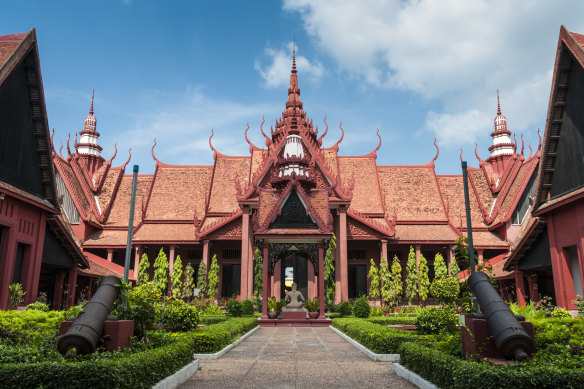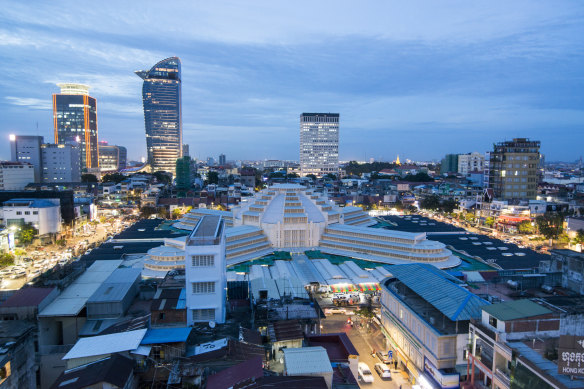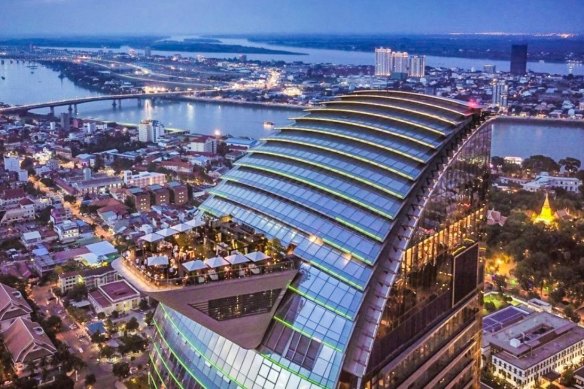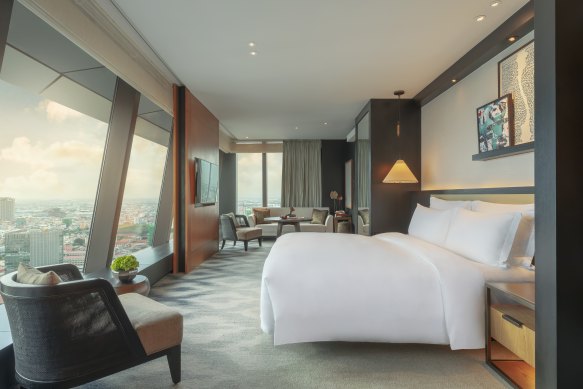I’m sipping a negroni at a rooftop bar, watching distant neon illuminations come to life as the sun dips over the horizon. Thirty-seven storeys below, honking traffic jams herald another chaotic Friday night as revellers head out on the town, searching for the next good meal or watering hole to wash away the stresses of the working week.

This scene, surrounded by a sea of skyscrapers competing for airspace, is one familiar to many bustling South-East Asian cities. But this is Phnom Penh – once the “country cousin” of the region, a formerly sleepy town emerging from decades of civil war and unrest, and a city historically ignored by mainstream tourism.
While in terms of visitor numbers it still plays second fiddle to Siem Reap – gateway to the incredible World Heritage-listed temples of Angkor – Cambodia’s capital has certainly come a long way since my first visit in 2009. Back then, the tallest buildings were the beautiful two- and three-storey French colonial mansions that once earned it the moniker the “Pearl of the Orient”. All the tourist activity took place along the riverfront, where the lively FCC (Foreign Correspondents’ Club) was the place to herald the night.

Today, the city has been reshaped as more than 50 skyscrapers of 40 floors or more pierce the sky. At least half of the city’s historically significant buildings have been razed, replaced by modern condos, high-end hotels and shopping malls. The FCC is under wraps, with an unknown reopening date, while strolling past the shops facing the Mekong is an impossibility, due to massive SUVs parked illegally on the footpath.
For a bird’s-eye view of this rapidly evolving and increasingly chaotic city, there’s no better spot than from the Sora skybar at Rosewood Phnom Penh, a luxury hotel located in the top 14 floors of Phnom Penh’s first skyscraper, Vattanac Capital Tower. Built in 2012 to resemble a mythical naga serpent (guardians of treasure in Hindu mythology), this tower – the tallest building in the city between 2014 and 2022 – is now dwarfed by at least 10 other buildings, the tallest being the Morgan EnMaison 2 condo complex, which rises to 53 floors on the Mekong riverbank.

I’m curious to check out the area with the most recent construction, a former wetland on the Bassac River known as Diamond Island, now a concrete jungle of Chinese-funded and patronised casinos and condominiums. An inclusion in my three-night stay at Rosewood Phnom Penh is a complimentary four-hour remork, or electric tuk-tuk, tour of the city; but when I ask my driver to first take me to this area, he seems a little perplexed. Western tourists, he hints, tend not to visit the casino hub; it’s very much a Chinese realm, and never the twain shall meet.
I’m adamant, but while touring through this area is fascinating, I find little to lure me to linger, particularly during daylight hours. It’s shiny, new, but ultimately soulless – with the only colour being the cyberpunk neons that light up the buildings after dark.
I’m sipping a negroni at a rooftop bar, watching distant neon illuminations come to life as the sun dips over the horizon. Thirty-seven storeys below, honking traffic jams herald another chaotic Friday night as revellers head out on the town, searching for the next good meal or watering hole to wash away the stresses of the working week.

This scene, surrounded by a sea of skyscrapers competing for airspace, is one familiar to many bustling South-East Asian cities. But this is Phnom Penh – once the “country cousin” of the region, a formerly sleepy town emerging from decades of civil war and unrest, and a city historically ignored by mainstream tourism.
While in terms of visitor numbers it still plays second fiddle to Siem Reap – gateway to the incredible World Heritage-listed temples of Angkor – Cambodia’s capital has certainly come a long way since my first visit in 2009. Back then, the tallest buildings were the beautiful two- and three-storey French colonial mansions that once earned it the moniker the “Pearl of the Orient”. All the tourist activity took place along the riverfront, where the lively FCC (Foreign Correspondents’ Club) was the place to herald the night.

Today, the city has been reshaped as more than 50 skyscrapers of 40 floors or more pierce the sky. At least half of the city’s historically significant buildings have been razed, replaced by modern condos, high-end hotels and shopping malls. The FCC is under wraps, with an unknown reopening date, while strolling past the shops facing the Mekong is an impossibility, due to massive SUVs parked illegally on the footpath.
For a bird’s-eye view of this rapidly evolving and increasingly chaotic city, there’s no better spot than from the Sora skybar at Rosewood Phnom Penh, a luxury hotel located in the top 14 floors of Phnom Penh’s first skyscraper, Vattanac Capital Tower. Built in 2012 to resemble a mythical naga serpent (guardians of treasure in Hindu mythology), this tower – the tallest building in the city between 2014 and 2022 – is now dwarfed by at least 10 other buildings, the tallest being the Morgan EnMaison 2 condo complex, which rises to 53 floors on the Mekong riverbank.

I’m curious to check out the area with the most recent construction, a former wetland on the Bassac River known as Diamond Island, now a concrete jungle of Chinese-funded and patronised casinos and condominiums. An inclusion in my three-night stay at Rosewood Phnom Penh is a complimentary four-hour remork, or electric tuk-tuk, tour of the city; but when I ask my driver to first take me to this area, he seems a little perplexed. Western tourists, he hints, tend not to visit the casino hub; it’s very much a Chinese realm, and never the twain shall meet.
I’m adamant, but while touring through this area is fascinating, I find little to lure me to linger, particularly during daylight hours. It’s shiny, new, but ultimately soulless – with the only colour being the cyberpunk neons that light up the buildings after dark.
Perhaps one indication of a city’s growing sophistication is the presence of craft brewing and independent spirit distillers – and Phnom Penh is no exception. The new Samai rum distillery on Street 830 opens its doors as a bar and for distillery tours on Thursday nights, with original cocktails concocted from the collection of handcrafted rums, including the sensational Kampot Pepper rum.
Related Article

Cambodia
Forget Thailand and Vietnam: South-East Asia’s enticing new travel frontier
Back on the riverfront, there’s one quintessential Phnom Penh experience that has survived trends, economic growth and pandemics alike – dining on the communal mats at the open-air Night Market.
Bypass the crappy stalls selling fake designer handbags and go straight for the sizzling food stalls, where you can eat like royalty – albeit on the ground – for just a few dollars.
It’s a reminder that no matter how high a city soars, it’s in simple experiences like this that the heart and soul of its community is firmly rooted.
The writer travelled as a guest of Rosewood Phnom Penh.
The details
Fly
Air Asia flies from Sydney to Kuala Lumpur, then on to Phnom Penh in Cambodia. See airasia.com
Stay

A three-night stay at Rosewood Phnom Penh is part of the 12-night Ultimate Luxury Tour of Cambodia. From $US12,900 ($19,060) for two people, with the Phnom Penh visit including three nights’ accommodation, daily breakfasts, a 30-minute massage at Sense, A Rosewood Spa, and a four-hour tuk tuk city tour. Package valid until October 31, 2024. See rosewoodhotels.com


